Florida Wildflowers (With Pictures) – Identification Guide
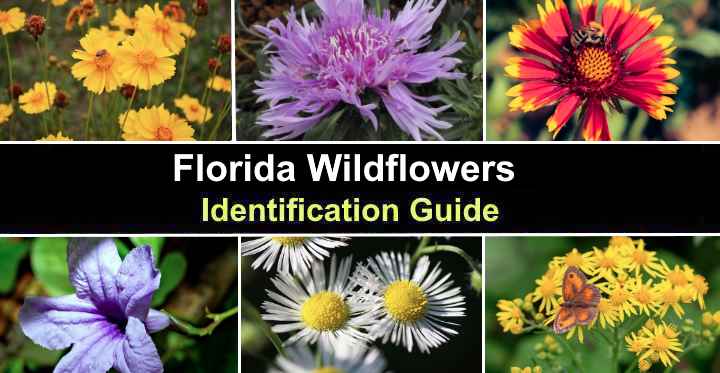
Florida wildflowers are a stunning addition to any garden landscape. These native plants have adapted to the Sunshine State’s unique climate and growing conditions. As a result, wildflowers in Florida’s meadows, woodlands, and open landscapes are easy to grow, low maintenance, and drought-tolerant. Planting Florida wildflowers lets you brighten a front or backyard with spectacular blooms in yellow, orange, pink, and purple shades.
Florida wildflowers also attract pollinators such as bees, caterpillars, butterflies, and hummingbirds, thus helping to support the state’s ecosystem and add natural beauty to your yard.
This article describes 16 of the most spectacular and colorful wildflowers that grow in Florida. Descriptions and pictures of the native wildflowers will help you identify and appreciate the unique beauty of Florida’s natural flora. You will also get tips on where to grow these wildflowers in your garden.
Flower Growing Zones in Florida
Florida has a diverse climate. The southern region has tropical conditions, whereas North and Central Florida have humid, subtropical conditions. Usually, the dry season starts earlier in North Florida, and temperatures can dip below freezing in winter. Therefore, some species of wildflowers will thrive year-long in the South but may struggle in winter in North Florida.
Florida has four USDA growing zones—Zone 8 to 11. These zones are determined by the average winter temperature. However, constant heat, humidity, and sunshine can affect growing factors. Therefore, growing Florida’s native wildflowers in the Sunshine State is best because they have adapted well to the local climate.
Common Wildflowers in Florida
The most common native wildflowers growing in the wild in Florida are coneflowers, milkweeds, fleabane, and common blue violet. In addition, many varieties of herbaceous wildflowers are common along roadsides, open fields, grasslands, forested wetlands, and prairies. Native Florida wildflowers also grow well in residential gardens in the appropriate zone.
Florida Wildflowers vs. Native Plants
Wildflowers are typically native Florida flowers that grow freely in open landscapes without being cared for. As a result, the plants thrive in Florida’s climate and soil conditions. Native plants also thrive in the southeastern United States but include shrubs, trees, vines, and bushes. On the other hand, wildflowers are typically herbaceous plants.
It’s important to note that both types of flowers—native plants and wildflowers—play important roles in southern ecosystems, providing the ideal habitat, food, and shelter for Florida’s wildlife and insects.
Florida Wildflowers to Grow in Your Garden (With Pictures)
Are you looking to spruce up your Florida yard with colorful wildflowers native to the Sunshine State? If so, please read on to learn about the diverse range of wildflowers that are not only beautiful but also easy to grow in Florida
Florida Tickseed (Coreopsis)

Tickseeds are hardy drought tolerant wildflowers that are common in Florida
Tickseed is a sun-loving wildflower common throughout Florida. This perennial plant blooms with bright yellow, orange, red, or pink daisy-like flowers growing on long stems. Tickseed flowers bloom from late spring to fall. The heat-tolerant, drought-resistant plants grow up to 3 ft. (0.9 m) tall and spread 1 to 2 ft. (0.3 – 0.6 m) wide.
In 1991, coreopsis was designated as Florida’s official wildflower.
Tickseed is an ideal plant for a garden landscape. You can grow the yellow or red-flowering plants in cottage gardens, mixed borders, or along a foundation line where they get at least six hours of sunshine daily. Tickseed flowers also attract pollinators to your garden.
Most varieties of Florida’s state wildflowers thrive in USDA zones 4 to 9, making them ideal for growing in North and Central Florida. However, here are a few varieties of tickseed that thrive in South Florida:
- Leavenworth’s Tickseed (Coreopsis leavenworthii): Bright yellow ray flowers with a brown center.
- Tickseed’ Ruby Frost’ (Coreopsis’ Ruby Frost’): Long-lasting striking red flowers with pale pink to white margins.
- Tickseed’ Mardi Gras’ (Coreopsis’ Mardi Gras’): The distinctive brilliant yellow and red flowers have star-shaped blooms and feathery foliage.
Sun exposure: Full sun
Height and width: 1 to 4 ft. (0.3 – 1.2 m)
Bloom time: Late spring to early fall
USDA growing zones: 4 to 10
Planting time: October through January
Golden Ragwort (Packera aurea)
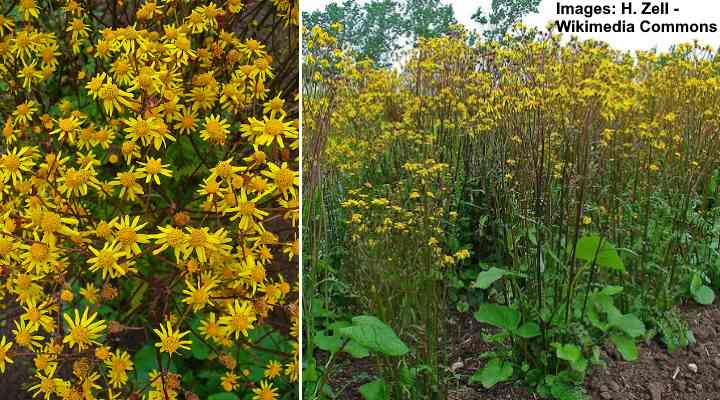
Golden ragwort is a Florida wildflower with clusters of yellow flowers on tall stems
Golden ragwort is native to Florida and is a perennial wildflower with bright yellow flowers that measure 1” (2.5 cm) across. This yellow-flowering plant has sparsely-leaved stems growing up to 3 ft. (1 m) tall, topped with clusters of daisy-like flowers. The wildflowers grow freely in partial shade or full sun.
Golden ragwort is ideal for planting in cottage gardens, mixed borders, or woodland gardens. You can also grow it as ground cover in dry, shaded landscapes. The wildflowers are common throughout North Florida and the Panhandle.
Sun exposure: Full sun or partial shade
Height and width: 1 to 3 ft. (0.3 – 1 m)
Bloom time: Spring through summer
USDA growing zones: 3 to 8
Planting time: Divide plants in spring to propagate
Soft Greeneyes (Berlandiera pumila)
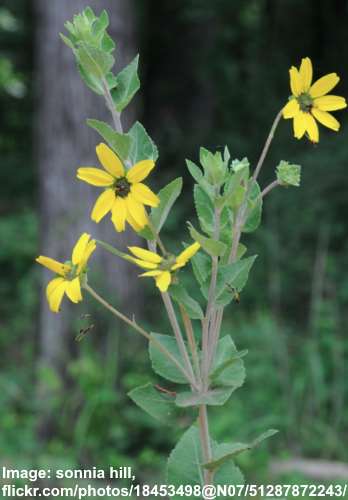
Soft greeneye wildflowers can be found in North and central Florida growing on tall stems
Native to Florida, soft greeneyes is a perennial wildflower growing naturally in North Florida. The wildflower is identified by its bright yellow ray florets, chocolatey scent, and velvety leaves with serrated margins. The green-centered yellow flowers grow on tall stems and bloom from late spring to early summer.
Drought-tolerant, low-maintenance, soft greeneyes grows 1 to 3 ft. (0.3 – 1 m) tall and 1 to 1.5 ft. (0.3 – 0.45 m) wide. The native flowers are ideal for planting in sunny, well-drained areas in North and Central Florida. The yellow wildflowers attract bees and butterflies. You can plant the deer-resistant flowers in cottage gardens, mixed borders, or as a yellow-flowering ground cover for full sun.
Sun exposure: Full sun or partial shade
Bloom time: Spring and summer
Height and width: 1 to 3 ft. (0.3 – 1 m) and wide
USDA growing zones: 8 and 9
Native Habitat: Dunes
Common Blue Violet (Viola sororia)
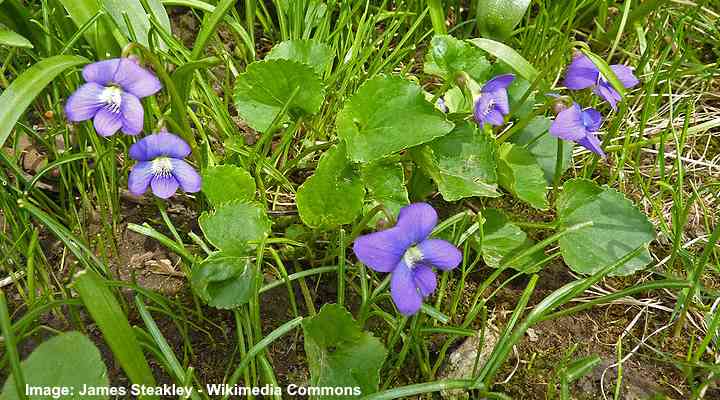
Common blue violet is a Florida native wildflower that is suitable as a low-maintenance ground cover plant
Common blue violet is a low-growing, purple-flowering wildflower with small, heart-shaped leaves. The purple or blue-violet pretty flowers have a unique shape with five petals on drooping, leafless stems. The plant grows 6” to 10” (15 – 25 cm) tall and spreads by underground rhizomes.
Common blue violet thrives in full sun throughout Florida. The native wildflower is an excellent ground cover plant with purple flowers. It also works well in rock gardens, coastal landscapes, and borders. In addition, it self-seeds and is tolerant of drought, making it exceedingly practical for low-maintenance gardens in southern Florida.
Sun exposure: Full sun to partial shade
Bloom time: Mid-spring until late summer
Height and width: 6” to 10” (15 – 25 cm) tall and wide
USDA growing zones: 3 to 10
Native Habitat: Rich, moist woods and swamps
Stokes Aster (Stokesia laevis)
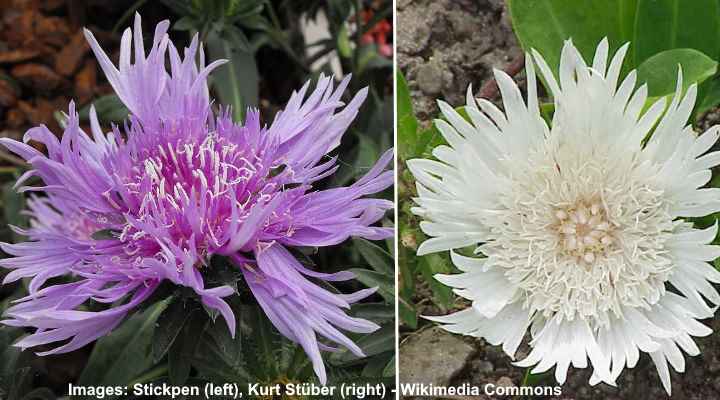
Stokes aster is an attractive Florida wildflower with feathery petals that come in shades of purple or white
Stokes aster is a sun-loving wildflower that produces showy purple, lavender, or white flowers. The large 2” to 4” (5 – 10 cm) florets resemble pale purple cornflowers and feature wiry white stamens in the center. The low-growing flowers contrast with the dark green, lance-shaped leaves.
Stokes aster is ideal for planting in sunny gardens, mixed borders, or as a ground cover. In addition, the low-maintenance plant is ideal for the warmer climates of Florida’s Central region, where its foliage remains evergreen throughout the year.
Sun exposure: Full sun or part shade
Bloom time: From May through September
Height and width: 1 to 2 ft. (0.3 – 0.6 m) tall and wide
USDA growing zones: 5 to 9
Native Habitat: Open woodlands, coastal plains, bogs, pine woods, and savannas
Carolina Wild Petunia (Ruellia caroliniensis)
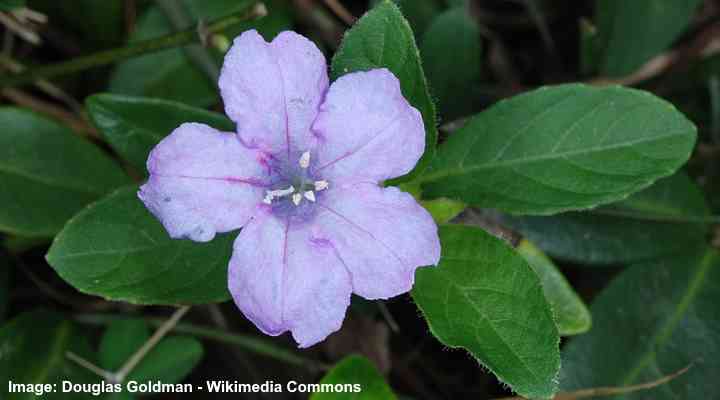
Carolina wild petunia can be grown as a purple flowering ground cover plant for shaded Florida gardens
Carolina wild petunia is a low-maintenance, spreading wildflower that thrives in Florida from the Panhandle to Miami. This attractive plant produces beautiful purple trumpet-shaped flowers in clusters of two to four. The low-growing ground cover plant is ideal for mass plantings, cascading over a wall, or hanging baskets.
Carolina wild petunia is ideal for partially shaded, dry conditions and tolerates poor soils. Due to its spreading habit, it’s a good ground cover plant for shade.
Sun exposure: Partial sun or full shade
Bloom time: Late spring until fall
Height and width: 1 ft. (0.3 m) tall and 1 to 2 ft. (0.3 – 0.6 m) wide
USDA growing zones: 8 to 11
Native Habitat: Open woods, uplands, and sandy areas
Pinewoods Milkweed (Asclepias humistrata)
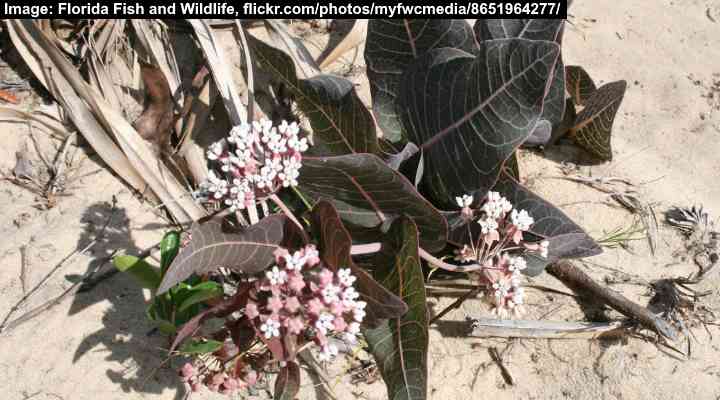
Pinewoods milkweed is a native Florida wildflower that is suitable for sandy soil and dry conditions
Pinewoods milkweed is a native Florida flower with creamy-white flower buds creating a spreading crown. The wild plant features large purple-veined leaves, and its white flowers are followed by brownish seeds. Milkweeds are vital wildflowers in Florida because they are a nectar source for monarch butterflies.
Plant pinewoods milkweed in well-drained sandy soil to encourage butterflies and pollinators to your Florida backyard. This hardy wildflower tolerates hot, dry conditions and sandy soils.
Sun exposure: Full sun
Bloom time: Early spring until mid-summer
Height and width: 1 to 3 ft. (0.3 – 1 m) tall and 1 ft. (0.3 m) wide
USDA growing zones: 8 and 9
Native Habitat: Pine woodlands, sandy hills, open forests
Oakleaf Fleabane (Erigeron quercifolius)
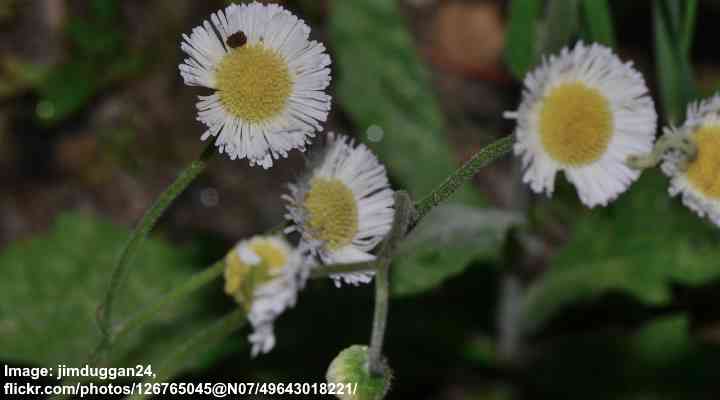
The drought tolerant oakleaf fleabane wildflower is suitable for growing in coastal regions of Florida
Also called southern fleabane, this short-lived herbaceous wildflower thrives throughout Florida, from Jacksonville to Ft. Myers and Miami. The attractive features of this native wildflower are its dainty daisy-like white or pink flowers with yellow disk centers. Additionally, the leaves are oak-like with deeply lobed margins.
Oakleaf fleabane is ideal for planting in borders, cottage gardens, rock gardens, and coastal landscapes. It’s tolerant to salt wind, drought, and constant sunshine, making it a great wildflower for growing in Florida.
Sun exposure: Full sun or partial shade
Bloom time: Spring and summer
Height and width: 1 to 2 ft. (0.3 – 0.6 m) tall and 9” (22 cm) wide
USDA growing zones: 8 to 11
Native Habitat: Sand dunes, moist hammocks, and roadsides in the southern United States
Beach Sunflower (Helianthus debilis)
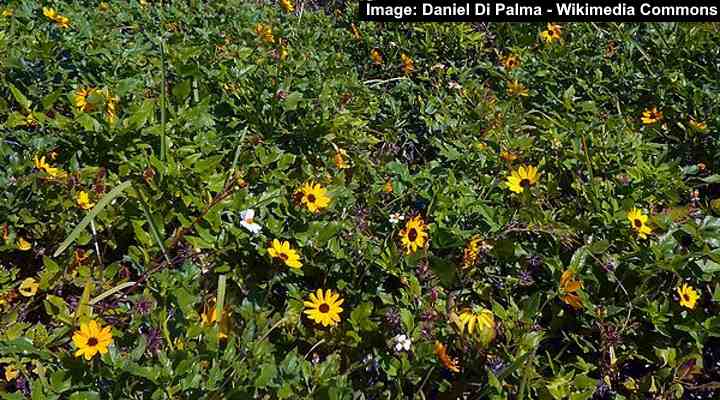
Beach sunflower is a full sun low maintenance ground cover perennial that grows well in Florida coastal zones
Beach sunflower is a yellow-flowering wildflower native to coastal regions of Florida. The eye-catching ray flowers have bright yellow with dark purplish-brown centers. The fast-growing native perennial plant is ideal for planting in coastal areas to form ground cover in full sun. The golden yellow flowers contrast with dark green, triangular leaves.
Beach sunflowers spread quickly and will bloom throughout the year from spring until fall. As well as ground cover, you can grow beach sunflowers to cascade over a retaining wall, or grow in a container on a balcony or patio.
Sun exposure: Full sun
Bloom time: Spring until fall
Height and width: 1 to 2 ft. (0.3 – 0.6 cm) tall and up to 4 ft. (1.2 m) wide
USDA growing zones: 8 to 11
Native Habitat: Disturbed areas in sand dunes and coastal regions
Narrowleaf Yellowtops (Flaveria linearis)

Narrowleaf yellowtop wildflowers grow well in sunny coastal areas in Florida and are drought tolerant
Narrowleaf yellowtops grow naturally in all regions of Florida, especially coastal plains. The attractive clusters of small yellow flowers contrast with the dark green narrow leaves. In addition, the small yellow flower clusters attract native Florida butterflies and pollinators. The yellow wildflowers are native to the southeastern United States and grow in well-drained soil and full sun.
Narrowleaf yellowtops are perfect for hot, sunny locations and can tolerate drought conditions. They are ideal for giving a naturalized look to wildflower gardens, planting in rock gardens, borders, or growing as tall ground cover.
Sun exposure: Full sun
Bloom time: Throughout the year in Florida
Height and width: 2 to 3 ft. (0.6 – 1 m) tall and 4 ft. (1.2 m) wide
USDA growing zones: 8 to 11
Native Habitat: Wet prairies, mangrove swamps, tidal marsh areas, sand dunes
Pinkscale Blazing Star (Liatris elegans)

Pinkscale blazing star wildflowers come in shades of pink, white or purple and grow on tall stems
Pinkscale blazing star is a native Florida wildflower noted for its tall spikes of pink, white or purple flowers. The scale-like flowers grow as cylindrical clusters on tall, upright stems. Its grass-like foliage is green and turns bronze in the fall. You can grow these wildflowers as far south as Miami and north of Pensacola.
Pinkscale blazing star is an easy-care plant ideal for sunny borders, meadow gardens, and naturalized areas. Its bottlebrush-like flowers add texture and a vertical accent to southern gardens.
Sun exposure: Full sun
Bloom time: Late summer and early fall
Height and width: 2 to 4 ft. (0.6 – 1.2 m) tall and 1 to 2 ft. (0.3 – 0.6 m) wide
USDA growing zones: 8 to 10
Native Habitat: Well-drained sandy soils, pine woodlands, and prairies
Swamp Sunflower (Helianthus angustifolius)
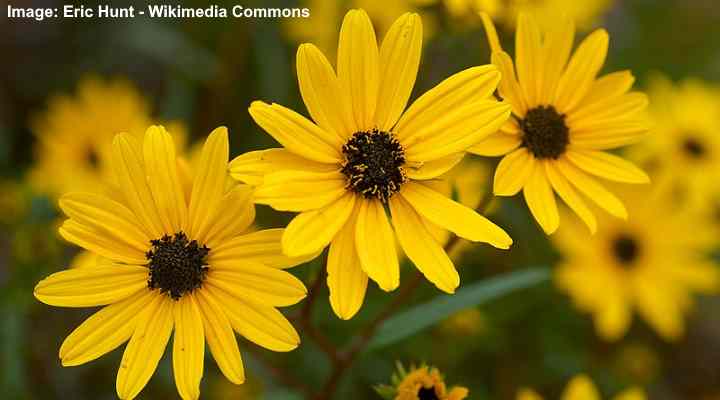
Swamp sunflowers are tall wildflowers that add vertical accent to Florida coastal landscapes or along streams
Swamp sunflower is a tall, upright wildflower native to the southeastern United States. The yellow flowers resemble miniature sunflowers—linear yellow petals forming rays around a brown center. Suitable for naturalized areas, the fast-growing perennial forms clumps of sturdy foliage and masses of bright yellow flowers on tall stems.
Due to their height, swamp sunflowers make excellent background plants in sunny garden landscapes. In addition, the nectar-rich flowers attract pollinators, including bees and butterflies. You can plant the flowers along streams, near ponds, and in beachfront, coastal gardens.
Sun exposure: Full sun to partial shade
Bloom time: Fall
Height and width: 5 to 8 ft. (1.5 – 2.4 m) tall and 4 ft. (1.2 m) wide
USDA growing zones: 5 to 10
Native Habitat: Flood plains and marshy ground
Black-Eyed Susan (Rudbeckia hirta)
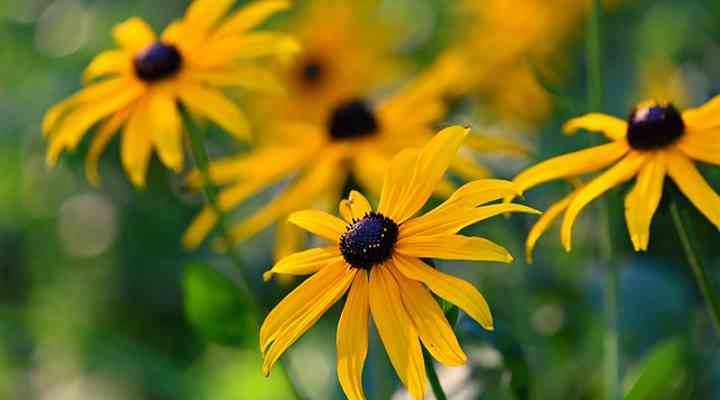
Black-eyed Susan is a common Florida wildflower for full sun that tolerates Florida summer heat
Black-eyed Susan is one of the most common tall native wildflowers in Florida. The eye-catching bright yellow daisy-like flowers bloom at the top of erect, upright stems. Many varieties of these tall flowers have drooping petals, forming a cone shape. The wildflowers naturally self-seed, making them easy to grow in a cottage garden.
Black-eyed Susans thrive in full sun and dry to moist, well-drained soils. These hardy perennials thrive in all Florida growing zones and continue flowering in the fall when many flowering shrubs start to fade. You can plant these flowering wildflowers along a foundation line, in mixed borders, or back of the bed planting.
Sun exposure: Full sun
Bloom time: Summer until late fall
Height and width: 2 to 3 ft. (0.6 – 1 m) tall and 2 ft. (0.6 m) wide
USDA growing zones: 3 to 10
Native Habitat: Open rocky woods, dry prairies, upland woodlands, meadows, pastures, and grasslands
Butterfly Weed (Asclepias tuberosa)
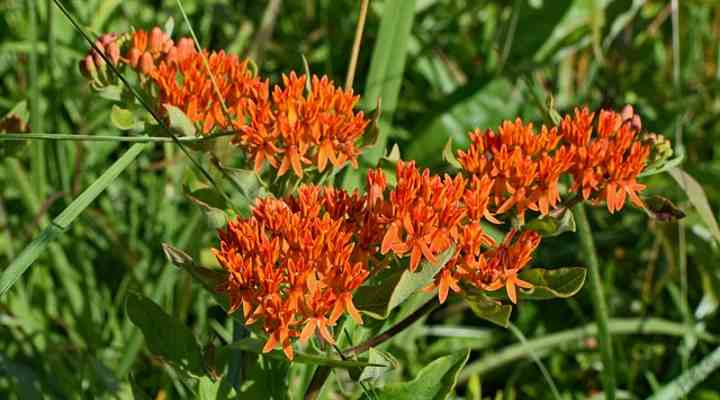
Butterfly weed is a drought-tolerant full-sun wildflower that attract pollinators such as butterflies, honey bees, and other insects
Butterfly weed is a variety of milkweed—a native perennial plant in Florida. The eye-catching features of butterfly weed are its showy clusters of bright orange and elongated lance-shaped leaves. Vibrant flowers bloom in early summer, attracting butterflies, bees, and other pollinators.
Butterfly weed is easy to grow from seed and is ideal for landscaping southern gardens. Its tubular orange flowers add a pop of color from late spring through fall. Unlike other types of milkweed, this native plant doesn’t exude the milky latex substance typical of wildflowers in the Asclepias genus.
Sun exposure: Full sun
Bloom time: Late spring through fall
Height and width: 1 to 3 ft. (0.3 – 1 m) tall and 2 ft. (0.6 m) wide
USDA growing zones: 8 to 10
Native Habitat: Sandy uplands, meadows, roadsides, pine flatwoods, and pastures
Blanket Flower (Gaillardia pulchella)
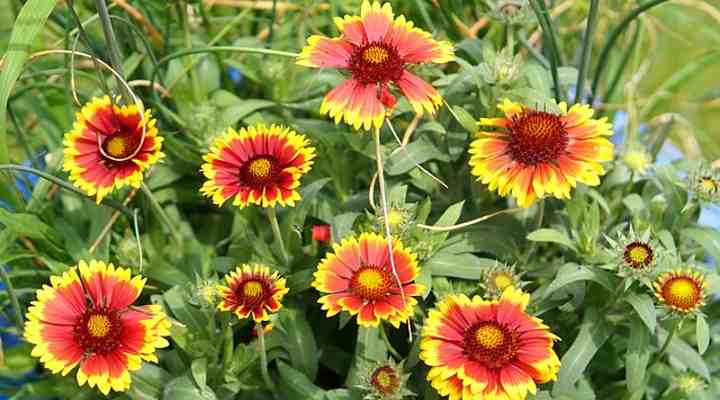
The beautiful blanket flowers give a bright focal point to sunny dry Florida gardens
Blanket flower is one of the most colorful wildflowers native to Florida. Thriving in full sun, the showy red, orange, and yellow create a blanket of color in Florida’s prairies and meadows. The daisy-like flowers have yellow-tipped bright red petals with brownish-red disk centers that attract pollinators, native bees, and butterflies.
Blanket flowers are ideal for planting in sunny beds, borders, or rock gardens. The heat and drought-tolerant wildflower is also ideal for xeriscaping in poor, dry soils. In Florida, blanket flowers grow as short-lived perennials. In colder climates, you can plant them as annuals.
Sun exposure: Full sun
Bloom time: Late spring through fall
Height and width: 1 to 2 ft. ( 0.3 – 0.6 m) tall and 1 ft. (0.3 m) wide
USDA growing zones: 2 to 11
Native Habitat: Well-drained sandy soils, dry plains, open areas
Blue Porterweed (Stachytarpheta jamaicensis)
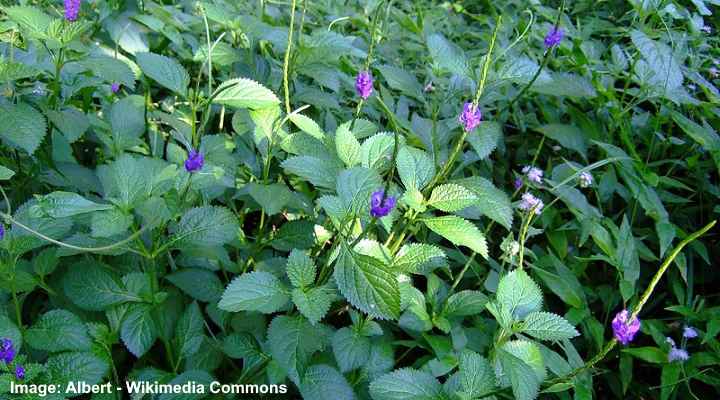
Blue porterweed is a purple evergreen wildflower native to Florida that can grow in full sun or partial shade
Also called beach vitex, blue porterweed is a sprawling native evergreen wildflower with clusters of dainty funnel-shaped flowers. Blooming throughout the year, this tropical Florida plant has trailing stems, dark green foliage, and lance-shaped, serrated leaves. The fragrant flowers attract native butterflies in the southeastern United States.
The slender spikes of blue porterweed grow around 15” (38 cm) tall. The native ground cover plant is ideal in coastal or inland regions of Florida as it tolerates drought, salt spray, and heat. It’s the perfect plant to create a butterfly garden in your backyard.
Sun exposure: Full sun or partial shade
Bloom time: On and off throughout the year
Height and width: 1 to 3 ft. (0.3 – 1 m) tall and wide
USDA growing zones: 8 to 11
Native Habitat: Coastal environments, native bushland, disturbed sites, tropical and subtropical regions
Related articles:
